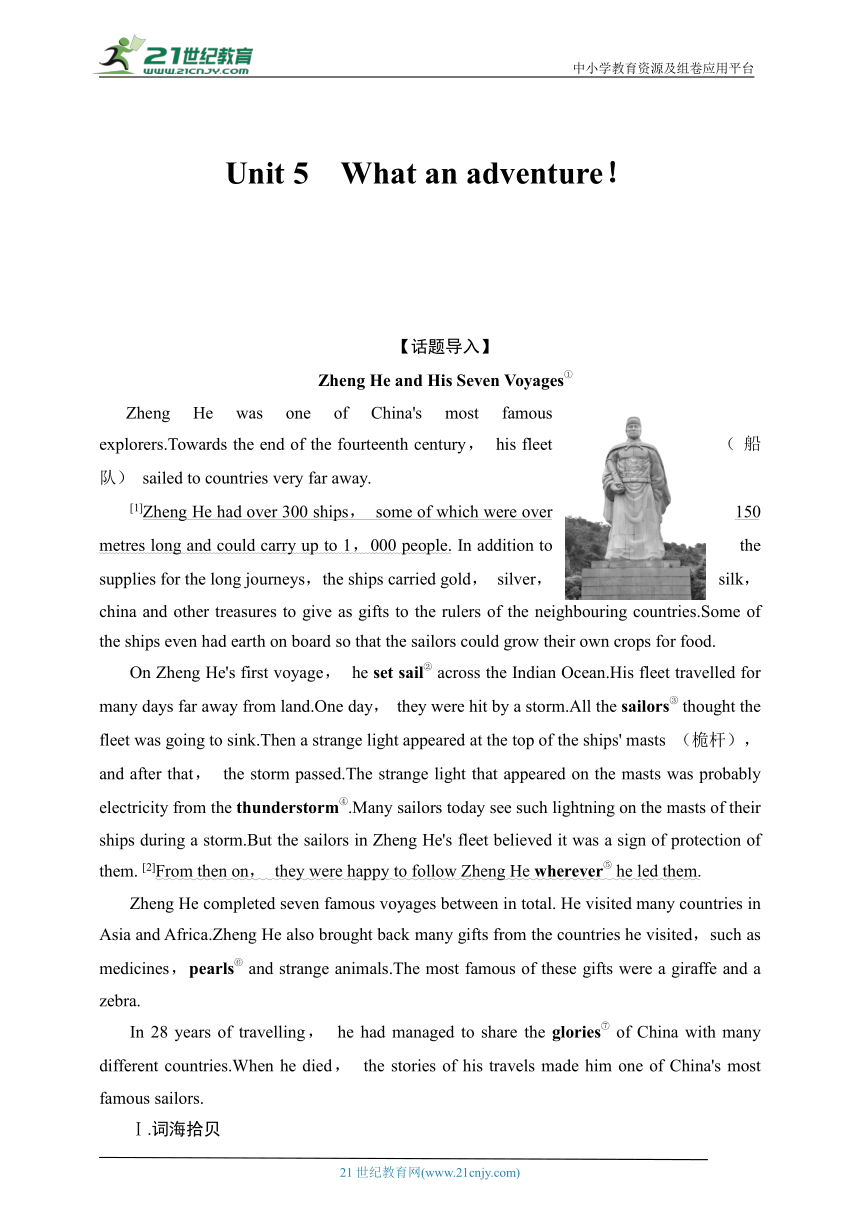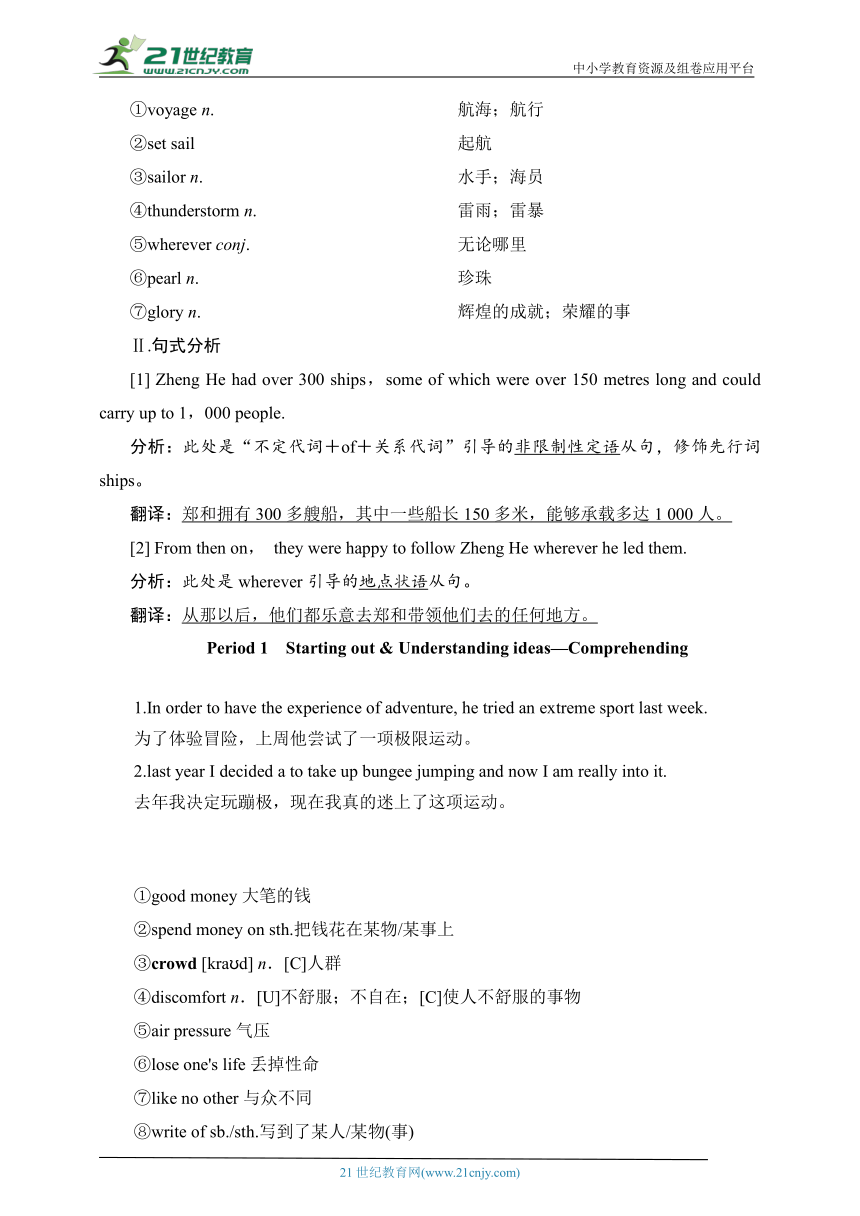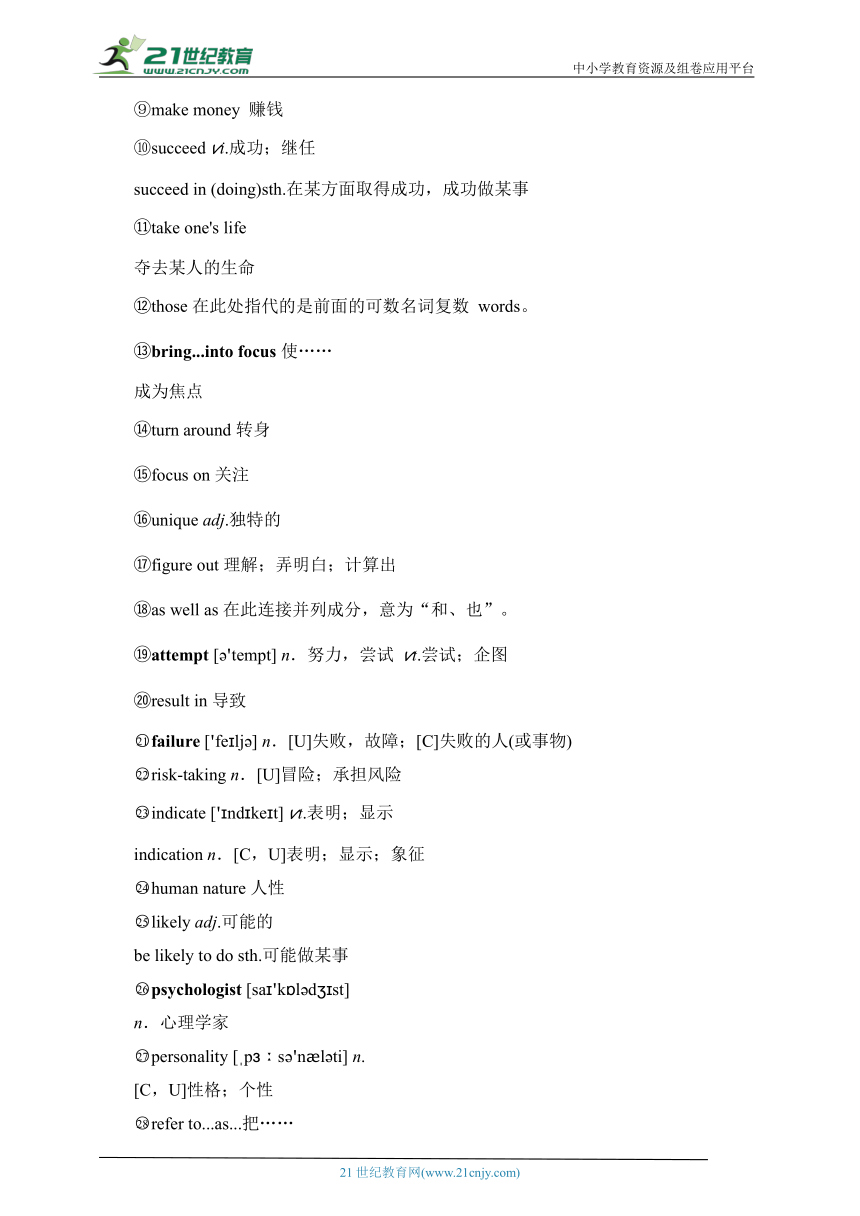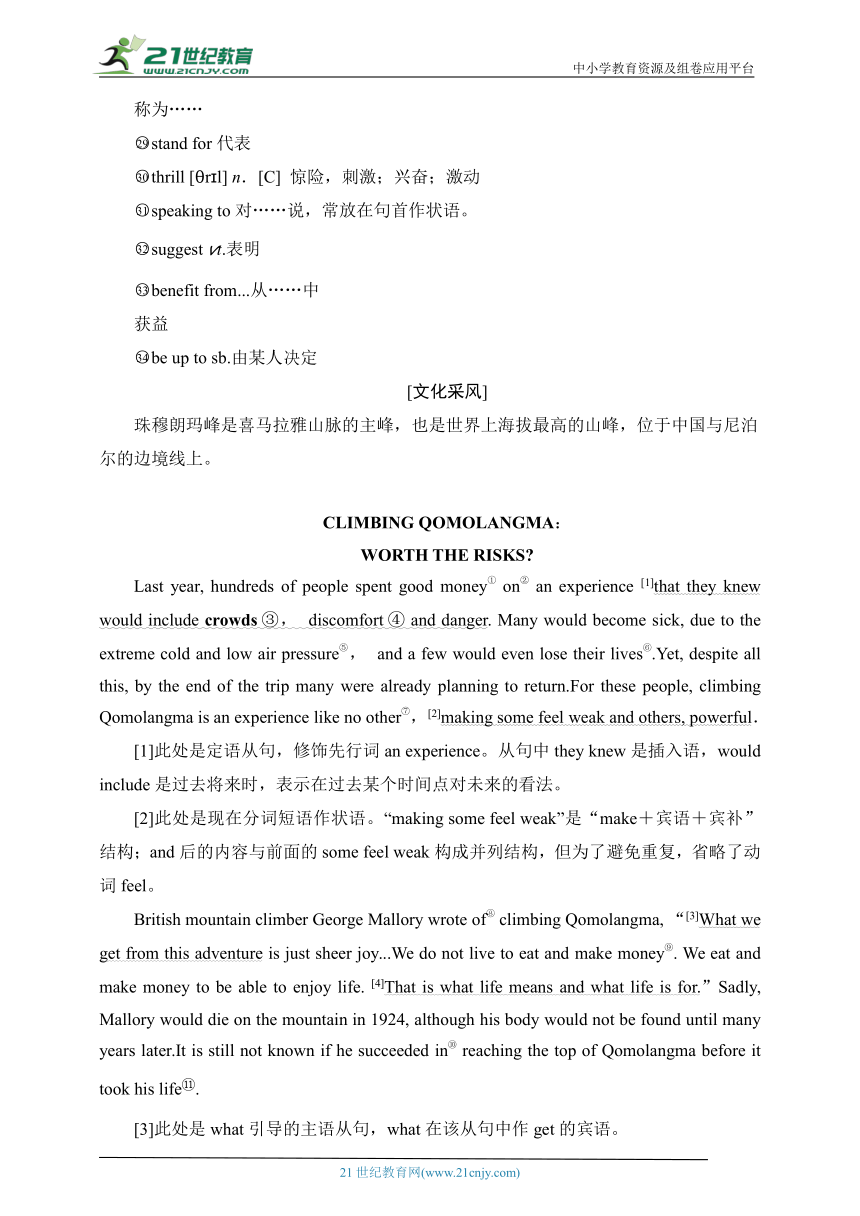高中英语外研版(2019)必修三 Unit 5 Period 1 学案
文档属性
| 名称 | 高中英语外研版(2019)必修三 Unit 5 Period 1 学案 |  | |
| 格式 | doc | ||
| 文件大小 | 1.6MB | ||
| 资源类型 | 试卷 | ||
| 版本资源 | 外研版(2019) | ||
| 科目 | 英语 | ||
| 更新时间 | 2022-12-05 13:05:09 | ||
图片预览




文档简介
中小学教育资源及组卷应用平台
Unit 5 What an adventure!
【话题导入】
Zheng He and His Seven Voyages①
Zheng He was one of China's most famous explorers.Towards the end of the fourteenth century, his fleet (船队) sailed to countries very far away.
[1]Zheng He had over 300 ships, some of which were over 150 metres long and could carry up to 1,000 people. In addition to the supplies for the long journeys,the ships carried gold, silver, silk, china and other treasures to give as gifts to the rulers of the neighbouring countries.Some of the ships even had earth on board so that the sailors could grow their own crops for food.
On Zheng He's first voyage, he set sail② across the Indian Ocean.His fleet travelled for many days far away from land.One day, they were hit by a storm.All the sailors③ thought the fleet was going to sink.Then a strange light appeared at the top of the ships' masts (桅杆), and after that, the storm passed.The strange light that appeared on the masts was probably electricity from the thunderstorm④.Many sailors today see such lightning on the masts of their ships during a storm.But the sailors in Zheng He's fleet believed it was a sign of protection of them. [2]From then on, they were happy to follow Zheng He wherever⑤ he led them.
Zheng He completed seven famous voyages between in total. He visited many countries in Asia and Africa.Zheng He also brought back many gifts from the countries he visited,such as medicines,pearls⑥ and strange animals.The most famous of these gifts were a giraffe and a zebra.
In 28 years of travelling, he had managed to share the glories⑦ of China with many different countries.When he died, the stories of his travels made him one of China's most famous sailors.
Ⅰ.词海拾贝
①voyage n. 航海;航行
②set sail 起航
③sailor n. 水手;海员
④thunderstorm n. 雷雨;雷暴
⑤wherever conj. 无论哪里
⑥pearl n. 珍珠
⑦glory n. 辉煌的成就;荣耀的事
Ⅱ.句式分析
[1] Zheng He had over 300 ships,some of which were over 150 metres long and could carry up to 1,000 people.
分析:此处是“不定代词+of+关系代词”引导的非限制性定语从句,修饰先行词ships。
翻译:郑和拥有300多艘船,其中一些船长150多米,能够承载多达1 000人。
[2] From then on, they were happy to follow Zheng He wherever he led them.
分析:此处是wherever引导的地点状语从句。
翻译:从那以后,他们都乐意去郑和带领他们去的任何地方。
Period 1 Starting out & Understanding ideas—Comprehending
1.In order to have the experience of adventure, he tried an extreme sport last week.
为了体验冒险,上周他尝试了一项极限运动。
2.last year I decided a to take up bungee jumping and now I am really into it.
去年我决定玩蹦极,现在我真的迷上了这项运动。
①good money大笔的钱
②spend money on sth.把钱花在某物/某事上
③crowd [kra d] n.[C]人群
④discomfort n.[U]不舒服;不自在;[C]使人不舒服的事物
⑤air pressure气压
⑥lose one's life丢掉性命
⑦like no other与众不同
⑧write of sb./sth.写到了某人/某物(事)
⑨make money 赚钱
⑩succeed vi.成功;继任
succeed in (doing)sth.在某方面取得成功,成功做某事
take one's life
夺去某人的生命
those在此处指代的是前面的可数名词复数 words。
bring...into focus使……
成为焦点
turn around转身
focus on关注
unique adj.独特的
figure out理解;弄明白;计算出
as well as在此连接并列成分,意为“和、也”。
attempt [ 'tempt] n.努力,尝试 vt.尝试;企图
result in导致
failure ['fe lj ] n.[U]失败,故障;[C]失败的人(或事物)
risk taking n.[U]冒险;承担风险
indicate [' nd ke t] vt.表明;显示
indication n.[C,U]表明;显示;象征
human nature人性
likely adj.可能的
be likely to do sth.可能做某事
psychologist [sa 'k l d st]
n.心理学家
personality [ p s 'n l ti] n.
[C,U]性格;个性
refer to...as...把……
称为……
stand for代表
thrill [θr l] n.[C] 惊险,刺激;兴奋;激动
speaking to对……说,常放在句首作状语。
suggest vt.表明
benefit from...从……中
获益
be up to sb.由某人决定
[文化采风]
珠穆朗玛峰是喜马拉雅山脉的主峰,也是世界上海拔最高的山峰,位于中国与尼泊尔的边境线上。
CLIMBING QOMOLANGMA:
WORTH THE RISKS
Last year, hundreds of people spent good money① on② an experience [1]that they knew would include crowds ③, discomfort ④ and danger. Many would become sick, due to the extreme cold and low air pressure⑤, and a few would even lose their lives⑥.Yet, despite all this, by the end of the trip many were already planning to return.For these people, climbing Qomolangma is an experience like no other⑦, [2]making some feel weak and others, powerful.
[1]此处是定语从句,修饰先行词an experience。从句中they knew是插入语,would include是过去将来时,表示在过去某个时间点对未来的看法。
[2]此处是现在分词短语作状语。“making some feel weak”是“make+宾语+宾补”结构;and后的内容与前面的some feel weak构成并列结构,但为了避免重复,省略了动词feel。
British mountain climber George Mallory wrote of⑧ climbing Qomolangma, “[3]What we get from this adventure is just sheer joy...We do not live to eat and make money⑨. We eat and make money to be able to enjoy life. [4]That is what life means and what life is for.”Sadly, Mallory would die on the mountain in 1924, although his body would not be found until many years later.It is still not known if he succeeded in⑩ reaching the top of Qomolangma before it took his life .
[3]此处是what引导的主语从句,what在该从句中作get的宾语。
[4]本句中,and连接两个并列的表语从句,what在这两个表语从句中均作宾语。
In 2011, words similar to those of Mallory were spoken by American mountain climber Alan Arnette, [5]who climbed Qomolangma in that year and was going to climb other high mountains around the world. “[6]It brings into focus what's important to you.” He added, “There are a thousand reasons to turn around and only one to keep going. You really have to focus on the one reason that's most important and unique to you. It forces you to look deep inside yourself and figure out if you really have the physical, as well as mental, toughness to push when you want to stop.”
[5]此处是who引导的非限制性定语从句,修饰先行词Alan Arnette, who在定语从句中作主语。
[6]本句的正常语序应是“It brings what's important to you into focus.”,由于宾语部分太长,介词短语太短,为了保持句子结构的平衡,宾语放在了后面。
[7]With the majority of attempts to climb Qomolangma resulting either in total success or failureB21, is there also a scientific reason behind this risk taking? Recent studies indicate that risk taking may be part of human nature, with some of us more likely to take risks than others. Psychologist Frank Farley has spent years studying people who jump out of planes and drive fast cars, as well as those who climb Qomolangma. He refers to the personalities of these people as“Type T”, with the “T” standing for “thrill”.
[7]此处是“with+宾语+宾补”结构,the majority of attempts是宾语,to climb Qomolangma是不定式作后置定语,修饰attempts;因attempts与result in之间是逻辑上的主谓关系,故用现在分词短语作宾补。
Speaking to the LA Times about the “Type T” personalities, Farley said, “They'll say, ‘I'm not taking risks, I'm an expert...’ They don't want to die and they don't expect to die.”
Research also suggests that our desire to seek risks can be connected to how much we expect to benefit from the result.
With this in mind, are the benefits of climbing Qomolangma worth the risks It's totally up to you.,
攀登珠穆朗玛峰:
值得冒险吗?
去年,数以百计的人花费大笔的钱,体验了明知会有拥挤、不适和危险的经历。由于极端寒冷和低气压,许多人会生病,少数人甚至可能会丧命。然而,尽管如此,到旅行结束时,许多人已经在盘算着还要再来。对于这些人来说,攀登珠穆朗玛峰是无可比拟的体验,有些人感到虚弱,而有些人则感到充满力量。
英国登山者乔治·马洛里这样记叙攀登珠穆朗玛峰的经历:“我们从这次冒险中获得的只是纯粹的喜悦……我们活着不是为了吃饭和赚钱,我们吃饭和赚钱是为了能享受生活。那就是生活的意义和目标。”可悲的是,马洛里于1924年在山上去世,而他的遗体直到多年以后才被找到。目前尚不清楚他是否在遇难前成功登顶珠穆朗玛峰。
2011年,美国登山者艾伦·阿内特说出了与马洛里类似的话。艾伦当年攀登了珠穆朗玛峰,并打算登上世界各地的其他高山。“登山会让你把注意力集中在对你来说重要的事情上。”他补充说,“有一千个理由让你转身,但只有一个理由让你继续前进。你必须专注于对你而言最重要、最独特的那个理由。它会驱使你深入观察自己的内心,并在想要停下的时候,弄清楚自己的身体和心理是否真的有韧劲继续前行。”
大部分攀登珠穆朗玛峰的尝试都以完全的成功或彻底的失败结束。那么,在这样的冒险背后是否也有一个科学的原因呢?最近的研究表明,冒险可能是人性的一部分,我们中的一些人要比其他人更可能冒险。心理学家弗兰克·法利已经花费了几年的时间研究那些跳伞、开快车和攀登珠穆朗玛峰的人。他将这些人的人格称为“T型”,“T”代表“thrill(刺激)”。
法利接受《洛杉矶时报》采访时是这样说“T型”人格的:“有人会说‘我不是在冒险,我是专家……’,他们不想死,不会想着失去生命。”
研究还表明,我们寻求冒险的愿望可能与我们期望从结果中获益的程度有关。
从这点来考虑,攀登珠穆朗玛峰的益处是否值得(人们)冒险呢?这完全取决于你。
Ⅰ.明主旨大意
What does the text mainly talk about
A.Bravely climbing Qomolangma.
B.The reasons of climbing Qomolangma.
C.Argument on climbing Qomolangma.
D.Whether to climb Qomolangma or not.
答案:C
Ⅱ.知层次结构
答案:1.attempts 2.crowds 3.enjoy life 4.sheer
5.unknown 6.most important and unique
7.toughness 8.experts 9.benefit from
Ⅰ.Read the text carefully and then choose the best answer.
1.What does the author try to tell us in paragraph 1
A.The great difficulty in climbing Qomolangma.
B.Two different kinds of Qomolangma climbers.
C.People's strong desire to climb the Qomolangma.
D.The great risks of climbing Qomolangma.
2.What happened to George Mallory eventually
A.He succeeded in reaching the top of Qomolangma.
B.He lost his life on the mountain.
C.He became world famous because he succeeded.
D.He survived with the help of Alan Arnette.
3.What would a person of “Type T” probably do
A.He is interested in making money.
B.He will not go for the mountain climbing.
C.He enjoys the excitement of mountain climbing.
D.He will be a success in his life journey.
4.According to research, why are some people keen on mountain climbing
A.Because they love to stay in the places with low air pressure.
B.Bacause they want to follow other people.
C.Because they focus on different reasons to succeed in life.
D.Because they have the “Type T” personalities or focus on the great benefits of the climbing.
答案:1-4.CBCD
Ⅱ.Analyze the following difficult sentences in the text.
1.For these people, climbing Qomolangma is an experience like no other, making some feel weak and others, powerful.
本句为复杂的简单句。climbing Qomolangma为动词 ing短语作主语;“making some feel weak and others, powerful”为现在分词短语作结果状语。
[翻译] 对于这些人来说,攀登珠穆朗玛峰是无可比拟的体验,有些人感到虚弱,而有些人则感到充满力量。
2.It's still not known if he succeeded in reaching the top of Qomolangma before it took his life.
本句为主从复合句。if引导主语从句,第一个it作形式主语;before引导时间状语从句。
[翻译] 目前尚不清楚他是否在遇难前成功登顶珠穆朗玛峰。
21世纪教育网 www.21cnjy.com 精品试卷·第 2 页 (共 2 页)
HYPERLINK "http://www.21cnjy.com/" 21世纪教育网(www.21cnjy.com)
Unit 5 What an adventure!
【话题导入】
Zheng He and His Seven Voyages①
Zheng He was one of China's most famous explorers.Towards the end of the fourteenth century, his fleet (船队) sailed to countries very far away.
[1]Zheng He had over 300 ships, some of which were over 150 metres long and could carry up to 1,000 people. In addition to the supplies for the long journeys,the ships carried gold, silver, silk, china and other treasures to give as gifts to the rulers of the neighbouring countries.Some of the ships even had earth on board so that the sailors could grow their own crops for food.
On Zheng He's first voyage, he set sail② across the Indian Ocean.His fleet travelled for many days far away from land.One day, they were hit by a storm.All the sailors③ thought the fleet was going to sink.Then a strange light appeared at the top of the ships' masts (桅杆), and after that, the storm passed.The strange light that appeared on the masts was probably electricity from the thunderstorm④.Many sailors today see such lightning on the masts of their ships during a storm.But the sailors in Zheng He's fleet believed it was a sign of protection of them. [2]From then on, they were happy to follow Zheng He wherever⑤ he led them.
Zheng He completed seven famous voyages between in total. He visited many countries in Asia and Africa.Zheng He also brought back many gifts from the countries he visited,such as medicines,pearls⑥ and strange animals.The most famous of these gifts were a giraffe and a zebra.
In 28 years of travelling, he had managed to share the glories⑦ of China with many different countries.When he died, the stories of his travels made him one of China's most famous sailors.
Ⅰ.词海拾贝
①voyage n. 航海;航行
②set sail 起航
③sailor n. 水手;海员
④thunderstorm n. 雷雨;雷暴
⑤wherever conj. 无论哪里
⑥pearl n. 珍珠
⑦glory n. 辉煌的成就;荣耀的事
Ⅱ.句式分析
[1] Zheng He had over 300 ships,some of which were over 150 metres long and could carry up to 1,000 people.
分析:此处是“不定代词+of+关系代词”引导的非限制性定语从句,修饰先行词ships。
翻译:郑和拥有300多艘船,其中一些船长150多米,能够承载多达1 000人。
[2] From then on, they were happy to follow Zheng He wherever he led them.
分析:此处是wherever引导的地点状语从句。
翻译:从那以后,他们都乐意去郑和带领他们去的任何地方。
Period 1 Starting out & Understanding ideas—Comprehending
1.In order to have the experience of adventure, he tried an extreme sport last week.
为了体验冒险,上周他尝试了一项极限运动。
2.last year I decided a to take up bungee jumping and now I am really into it.
去年我决定玩蹦极,现在我真的迷上了这项运动。
①good money大笔的钱
②spend money on sth.把钱花在某物/某事上
③crowd [kra d] n.[C]人群
④discomfort n.[U]不舒服;不自在;[C]使人不舒服的事物
⑤air pressure气压
⑥lose one's life丢掉性命
⑦like no other与众不同
⑧write of sb./sth.写到了某人/某物(事)
⑨make money 赚钱
⑩succeed vi.成功;继任
succeed in (doing)sth.在某方面取得成功,成功做某事
take one's life
夺去某人的生命
those在此处指代的是前面的可数名词复数 words。
bring...into focus使……
成为焦点
turn around转身
focus on关注
unique adj.独特的
figure out理解;弄明白;计算出
as well as在此连接并列成分,意为“和、也”。
attempt [ 'tempt] n.努力,尝试 vt.尝试;企图
result in导致
failure ['fe lj ] n.[U]失败,故障;[C]失败的人(或事物)
risk taking n.[U]冒险;承担风险
indicate [' nd ke t] vt.表明;显示
indication n.[C,U]表明;显示;象征
human nature人性
likely adj.可能的
be likely to do sth.可能做某事
psychologist [sa 'k l d st]
n.心理学家
personality [ p s 'n l ti] n.
[C,U]性格;个性
refer to...as...把……
称为……
stand for代表
thrill [θr l] n.[C] 惊险,刺激;兴奋;激动
speaking to对……说,常放在句首作状语。
suggest vt.表明
benefit from...从……中
获益
be up to sb.由某人决定
[文化采风]
珠穆朗玛峰是喜马拉雅山脉的主峰,也是世界上海拔最高的山峰,位于中国与尼泊尔的边境线上。
CLIMBING QOMOLANGMA:
WORTH THE RISKS
Last year, hundreds of people spent good money① on② an experience [1]that they knew would include crowds ③, discomfort ④ and danger. Many would become sick, due to the extreme cold and low air pressure⑤, and a few would even lose their lives⑥.Yet, despite all this, by the end of the trip many were already planning to return.For these people, climbing Qomolangma is an experience like no other⑦, [2]making some feel weak and others, powerful.
[1]此处是定语从句,修饰先行词an experience。从句中they knew是插入语,would include是过去将来时,表示在过去某个时间点对未来的看法。
[2]此处是现在分词短语作状语。“making some feel weak”是“make+宾语+宾补”结构;and后的内容与前面的some feel weak构成并列结构,但为了避免重复,省略了动词feel。
British mountain climber George Mallory wrote of⑧ climbing Qomolangma, “[3]What we get from this adventure is just sheer joy...We do not live to eat and make money⑨. We eat and make money to be able to enjoy life. [4]That is what life means and what life is for.”Sadly, Mallory would die on the mountain in 1924, although his body would not be found until many years later.It is still not known if he succeeded in⑩ reaching the top of Qomolangma before it took his life .
[3]此处是what引导的主语从句,what在该从句中作get的宾语。
[4]本句中,and连接两个并列的表语从句,what在这两个表语从句中均作宾语。
In 2011, words similar to those of Mallory were spoken by American mountain climber Alan Arnette, [5]who climbed Qomolangma in that year and was going to climb other high mountains around the world. “[6]It brings into focus what's important to you.” He added, “There are a thousand reasons to turn around and only one to keep going. You really have to focus on the one reason that's most important and unique to you. It forces you to look deep inside yourself and figure out if you really have the physical, as well as mental, toughness to push when you want to stop.”
[5]此处是who引导的非限制性定语从句,修饰先行词Alan Arnette, who在定语从句中作主语。
[6]本句的正常语序应是“It brings what's important to you into focus.”,由于宾语部分太长,介词短语太短,为了保持句子结构的平衡,宾语放在了后面。
[7]With the majority of attempts to climb Qomolangma resulting either in total success or failureB21, is there also a scientific reason behind this risk taking? Recent studies indicate that risk taking may be part of human nature, with some of us more likely to take risks than others. Psychologist Frank Farley has spent years studying people who jump out of planes and drive fast cars, as well as those who climb Qomolangma. He refers to the personalities of these people as“Type T”, with the “T” standing for “thrill”.
[7]此处是“with+宾语+宾补”结构,the majority of attempts是宾语,to climb Qomolangma是不定式作后置定语,修饰attempts;因attempts与result in之间是逻辑上的主谓关系,故用现在分词短语作宾补。
Speaking to the LA Times about the “Type T” personalities, Farley said, “They'll say, ‘I'm not taking risks, I'm an expert...’ They don't want to die and they don't expect to die.”
Research also suggests that our desire to seek risks can be connected to how much we expect to benefit from the result.
With this in mind, are the benefits of climbing Qomolangma worth the risks It's totally up to you.,
攀登珠穆朗玛峰:
值得冒险吗?
去年,数以百计的人花费大笔的钱,体验了明知会有拥挤、不适和危险的经历。由于极端寒冷和低气压,许多人会生病,少数人甚至可能会丧命。然而,尽管如此,到旅行结束时,许多人已经在盘算着还要再来。对于这些人来说,攀登珠穆朗玛峰是无可比拟的体验,有些人感到虚弱,而有些人则感到充满力量。
英国登山者乔治·马洛里这样记叙攀登珠穆朗玛峰的经历:“我们从这次冒险中获得的只是纯粹的喜悦……我们活着不是为了吃饭和赚钱,我们吃饭和赚钱是为了能享受生活。那就是生活的意义和目标。”可悲的是,马洛里于1924年在山上去世,而他的遗体直到多年以后才被找到。目前尚不清楚他是否在遇难前成功登顶珠穆朗玛峰。
2011年,美国登山者艾伦·阿内特说出了与马洛里类似的话。艾伦当年攀登了珠穆朗玛峰,并打算登上世界各地的其他高山。“登山会让你把注意力集中在对你来说重要的事情上。”他补充说,“有一千个理由让你转身,但只有一个理由让你继续前进。你必须专注于对你而言最重要、最独特的那个理由。它会驱使你深入观察自己的内心,并在想要停下的时候,弄清楚自己的身体和心理是否真的有韧劲继续前行。”
大部分攀登珠穆朗玛峰的尝试都以完全的成功或彻底的失败结束。那么,在这样的冒险背后是否也有一个科学的原因呢?最近的研究表明,冒险可能是人性的一部分,我们中的一些人要比其他人更可能冒险。心理学家弗兰克·法利已经花费了几年的时间研究那些跳伞、开快车和攀登珠穆朗玛峰的人。他将这些人的人格称为“T型”,“T”代表“thrill(刺激)”。
法利接受《洛杉矶时报》采访时是这样说“T型”人格的:“有人会说‘我不是在冒险,我是专家……’,他们不想死,不会想着失去生命。”
研究还表明,我们寻求冒险的愿望可能与我们期望从结果中获益的程度有关。
从这点来考虑,攀登珠穆朗玛峰的益处是否值得(人们)冒险呢?这完全取决于你。
Ⅰ.明主旨大意
What does the text mainly talk about
A.Bravely climbing Qomolangma.
B.The reasons of climbing Qomolangma.
C.Argument on climbing Qomolangma.
D.Whether to climb Qomolangma or not.
答案:C
Ⅱ.知层次结构
答案:1.attempts 2.crowds 3.enjoy life 4.sheer
5.unknown 6.most important and unique
7.toughness 8.experts 9.benefit from
Ⅰ.Read the text carefully and then choose the best answer.
1.What does the author try to tell us in paragraph 1
A.The great difficulty in climbing Qomolangma.
B.Two different kinds of Qomolangma climbers.
C.People's strong desire to climb the Qomolangma.
D.The great risks of climbing Qomolangma.
2.What happened to George Mallory eventually
A.He succeeded in reaching the top of Qomolangma.
B.He lost his life on the mountain.
C.He became world famous because he succeeded.
D.He survived with the help of Alan Arnette.
3.What would a person of “Type T” probably do
A.He is interested in making money.
B.He will not go for the mountain climbing.
C.He enjoys the excitement of mountain climbing.
D.He will be a success in his life journey.
4.According to research, why are some people keen on mountain climbing
A.Because they love to stay in the places with low air pressure.
B.Bacause they want to follow other people.
C.Because they focus on different reasons to succeed in life.
D.Because they have the “Type T” personalities or focus on the great benefits of the climbing.
答案:1-4.CBCD
Ⅱ.Analyze the following difficult sentences in the text.
1.For these people, climbing Qomolangma is an experience like no other, making some feel weak and others, powerful.
本句为复杂的简单句。climbing Qomolangma为动词 ing短语作主语;“making some feel weak and others, powerful”为现在分词短语作结果状语。
[翻译] 对于这些人来说,攀登珠穆朗玛峰是无可比拟的体验,有些人感到虚弱,而有些人则感到充满力量。
2.It's still not known if he succeeded in reaching the top of Qomolangma before it took his life.
本句为主从复合句。if引导主语从句,第一个it作形式主语;before引导时间状语从句。
[翻译] 目前尚不清楚他是否在遇难前成功登顶珠穆朗玛峰。
21世纪教育网 www.21cnjy.com 精品试卷·第 2 页 (共 2 页)
HYPERLINK "http://www.21cnjy.com/" 21世纪教育网(www.21cnjy.com)
